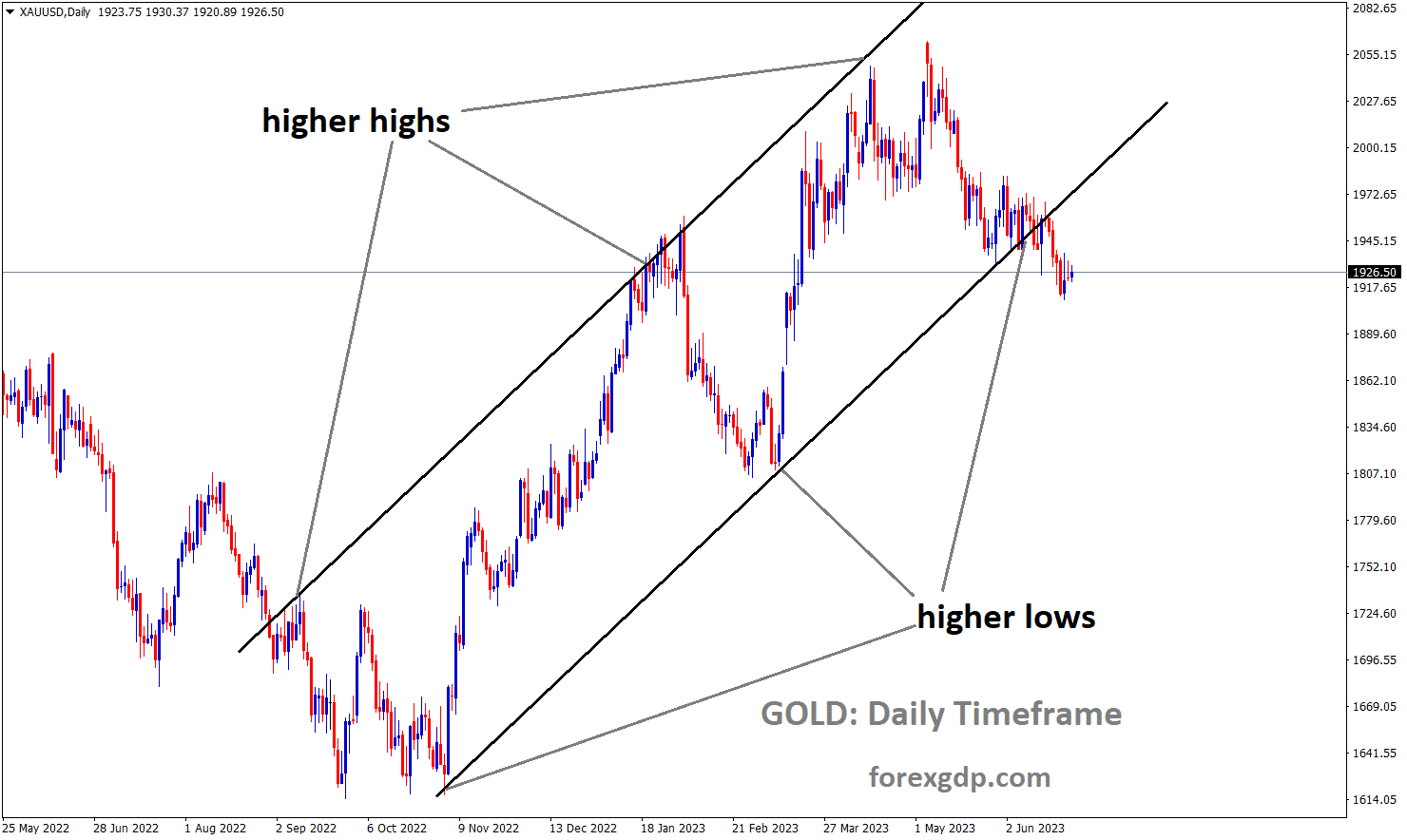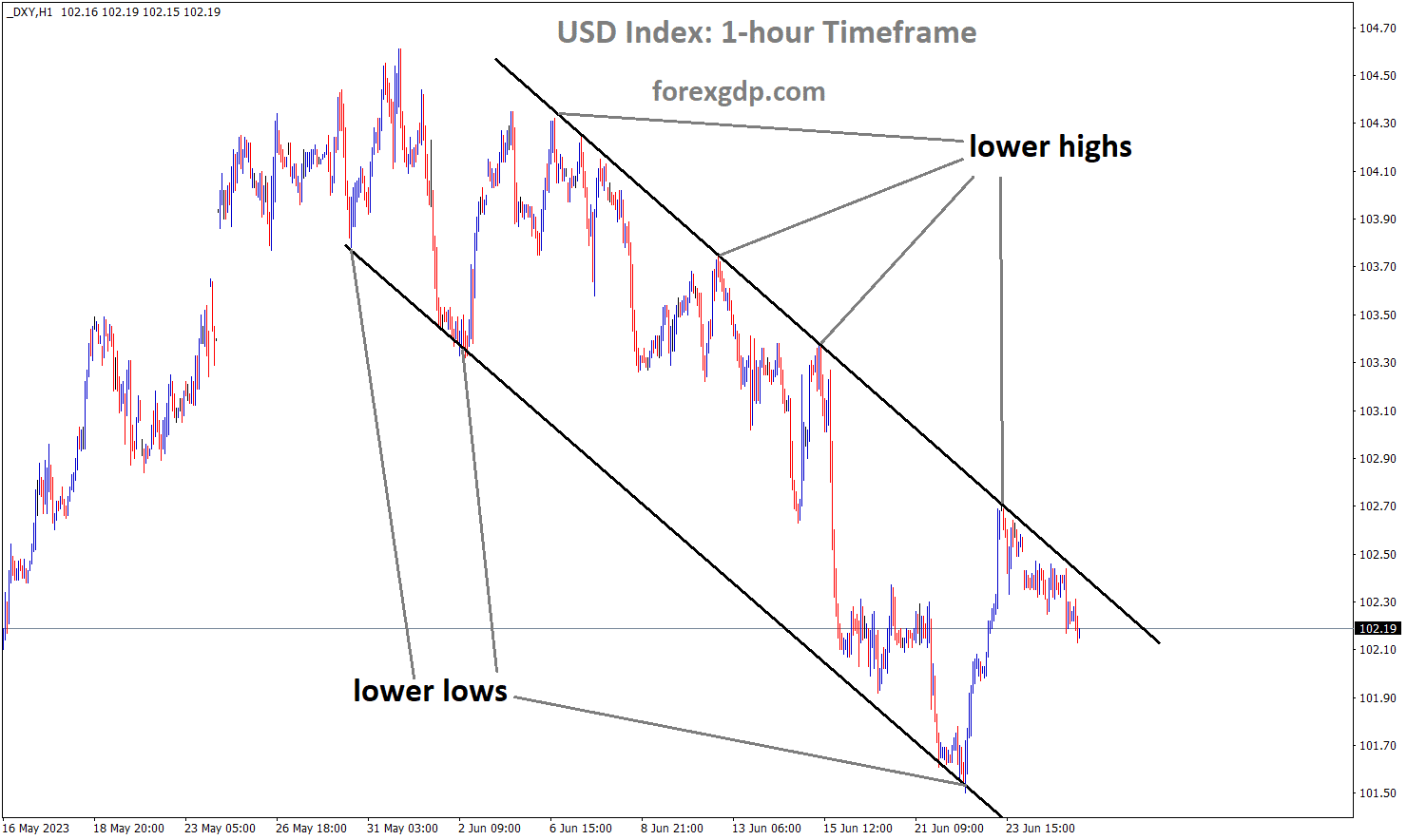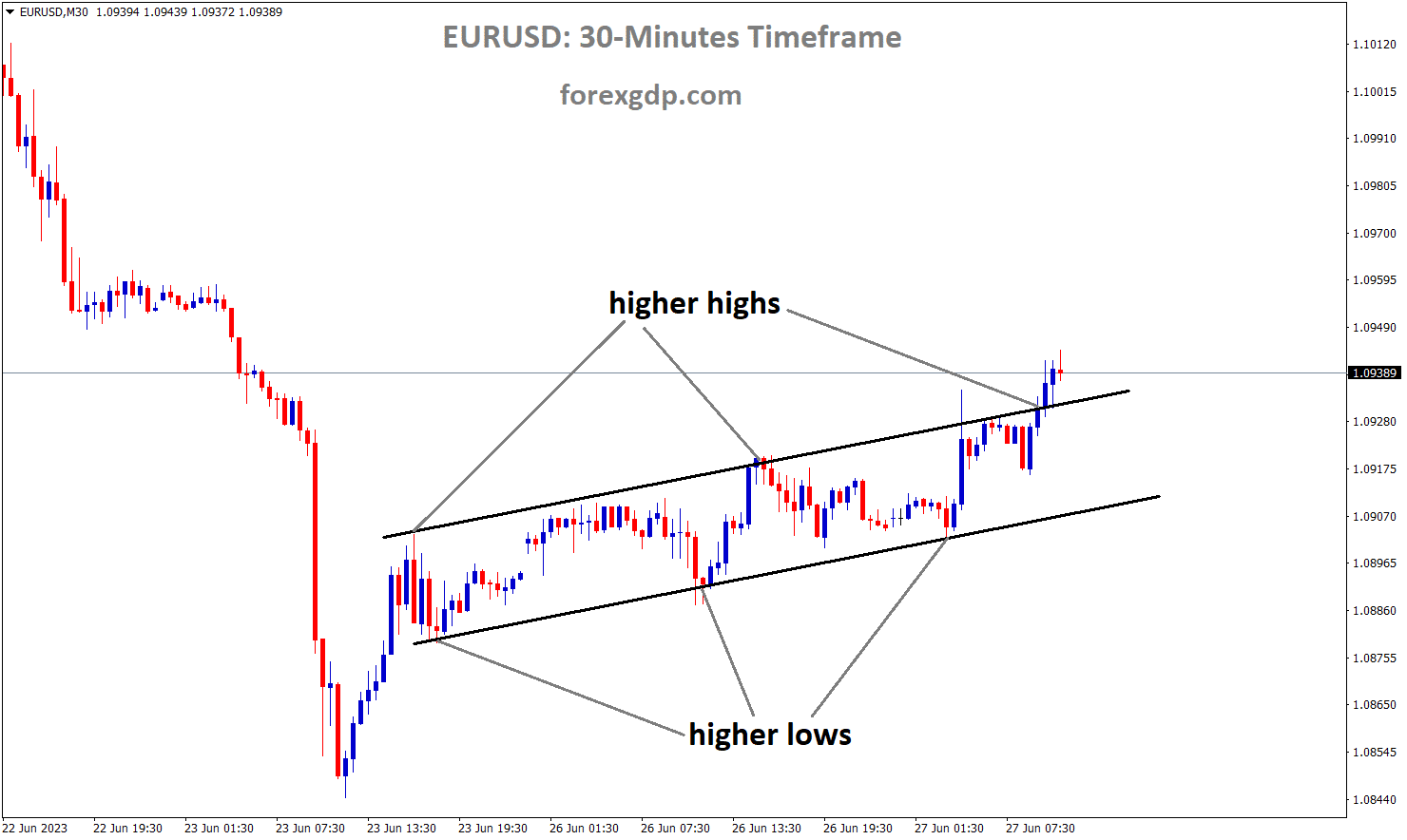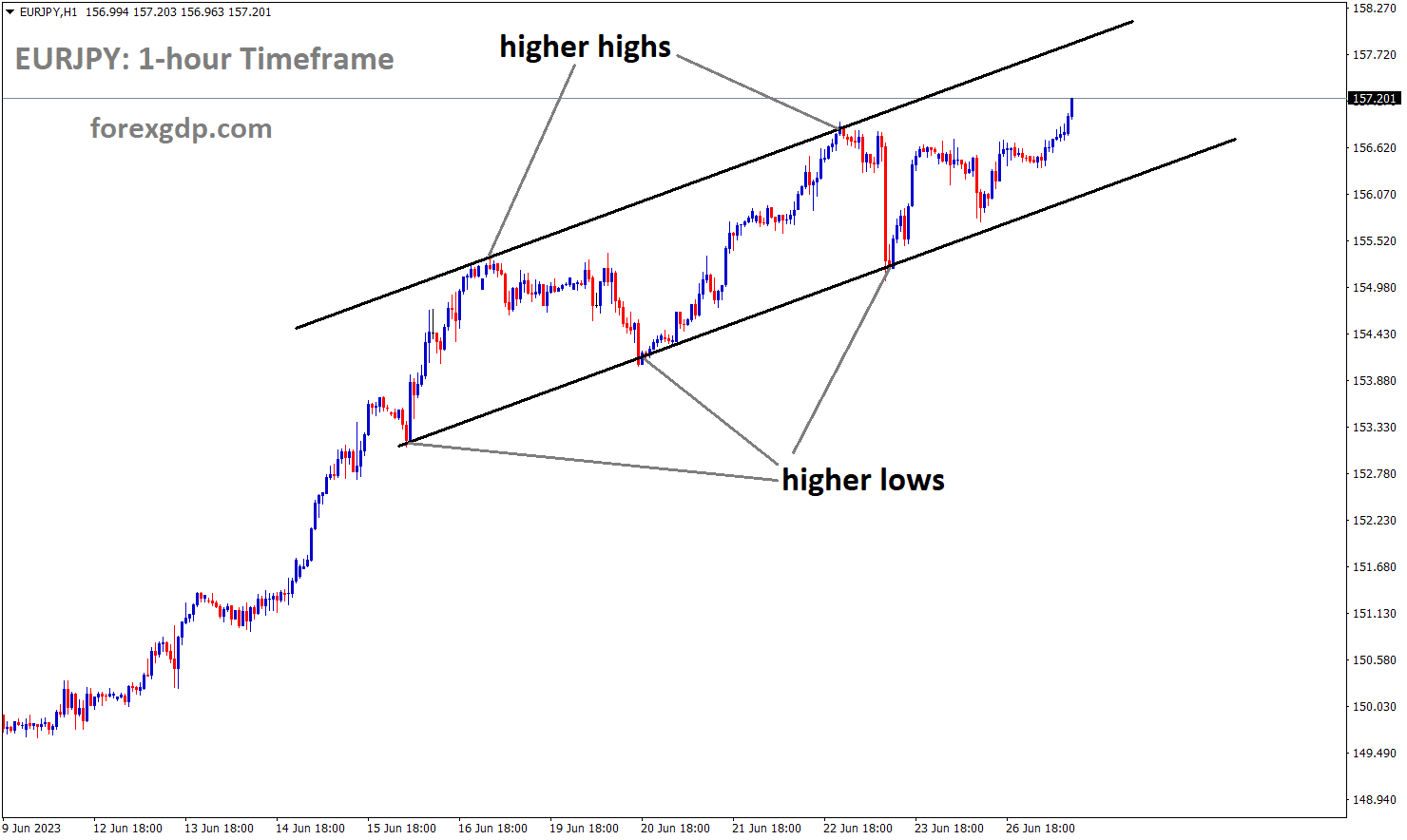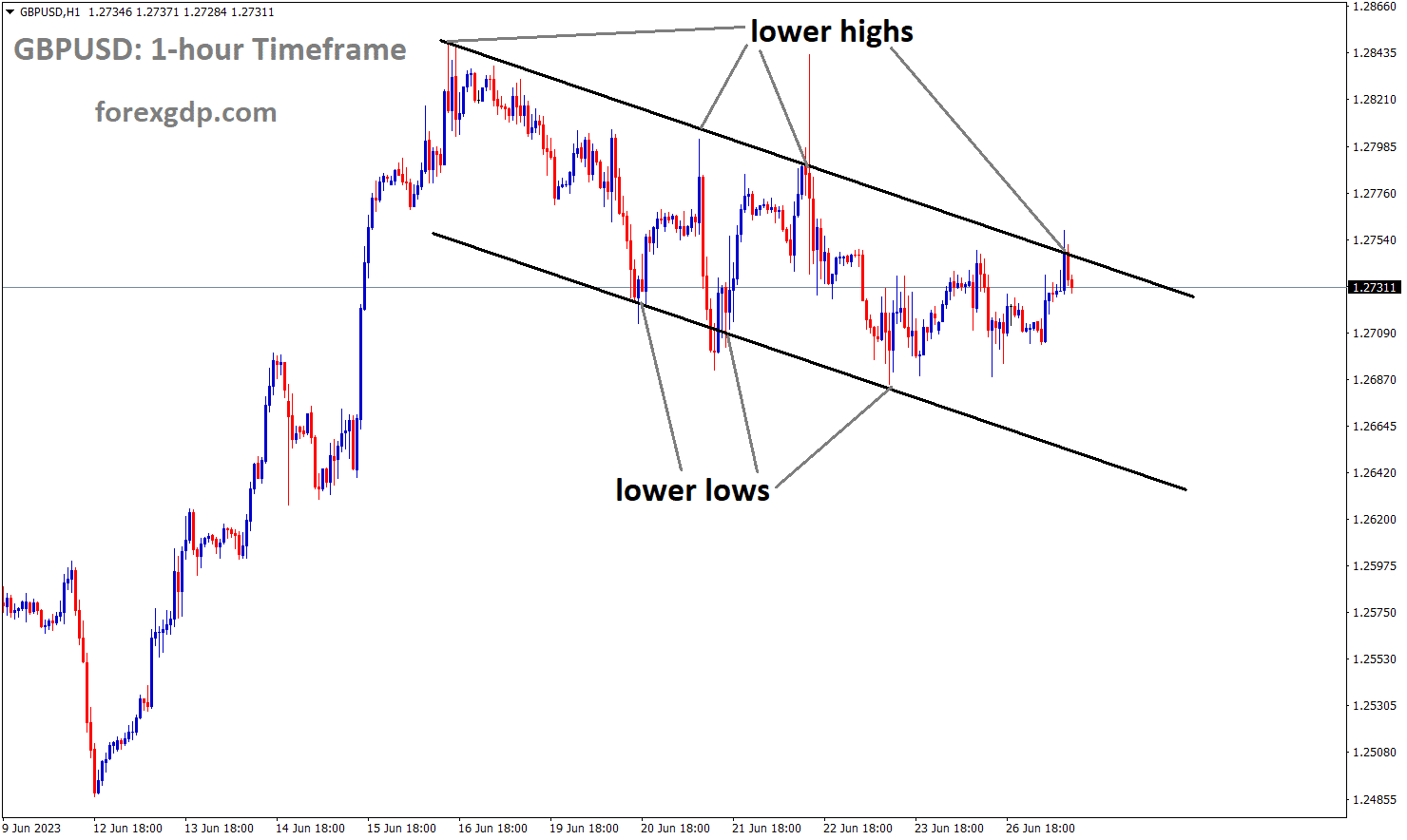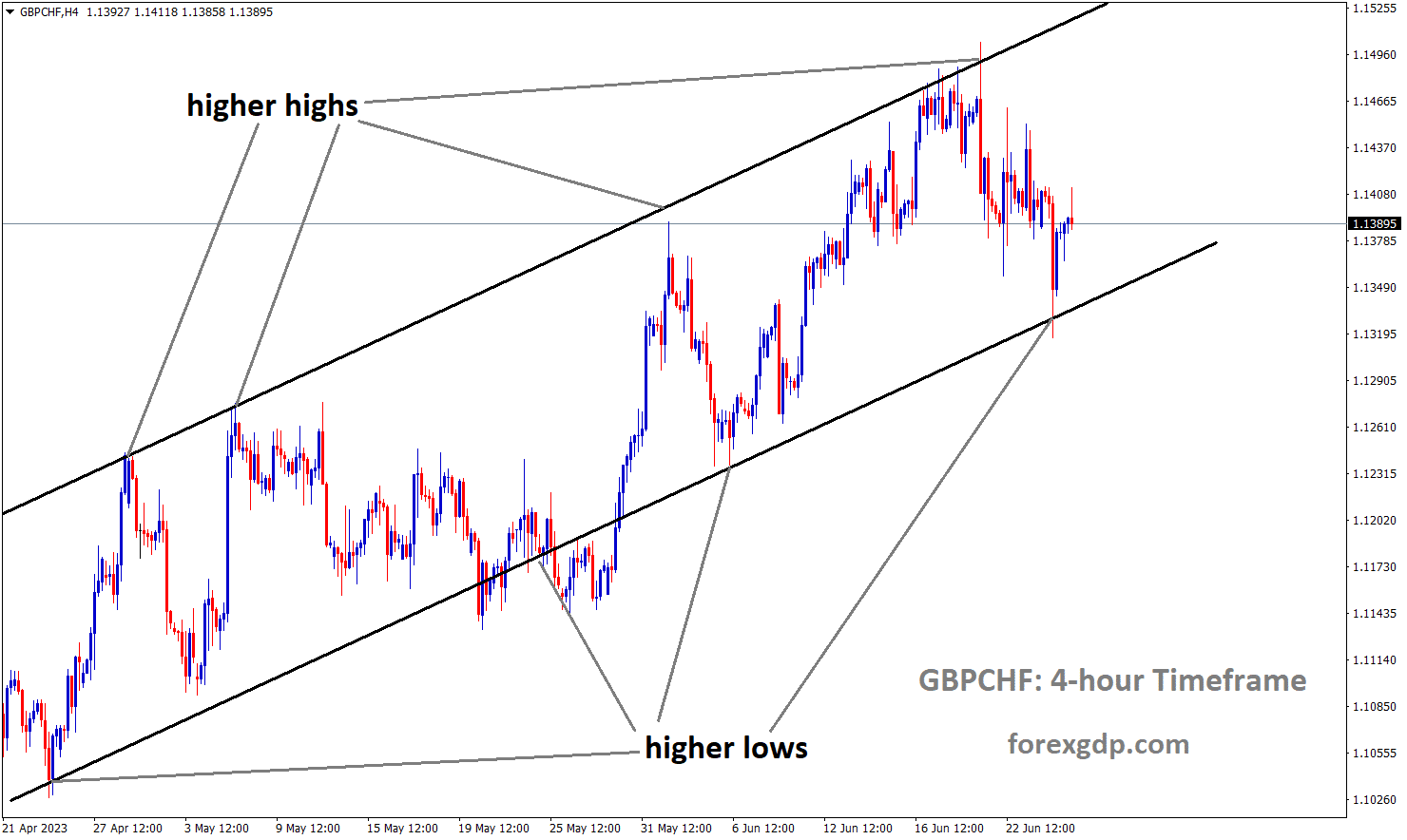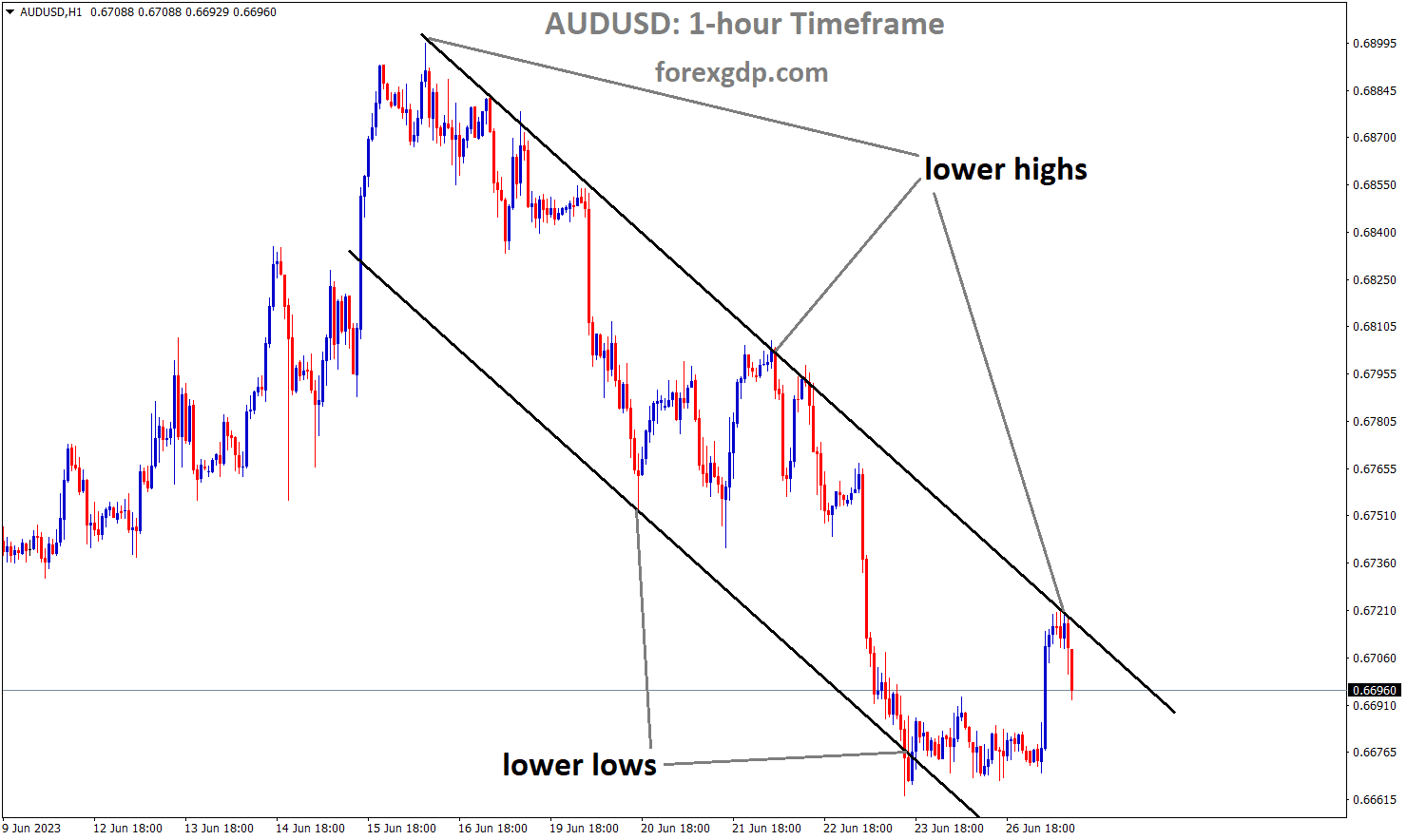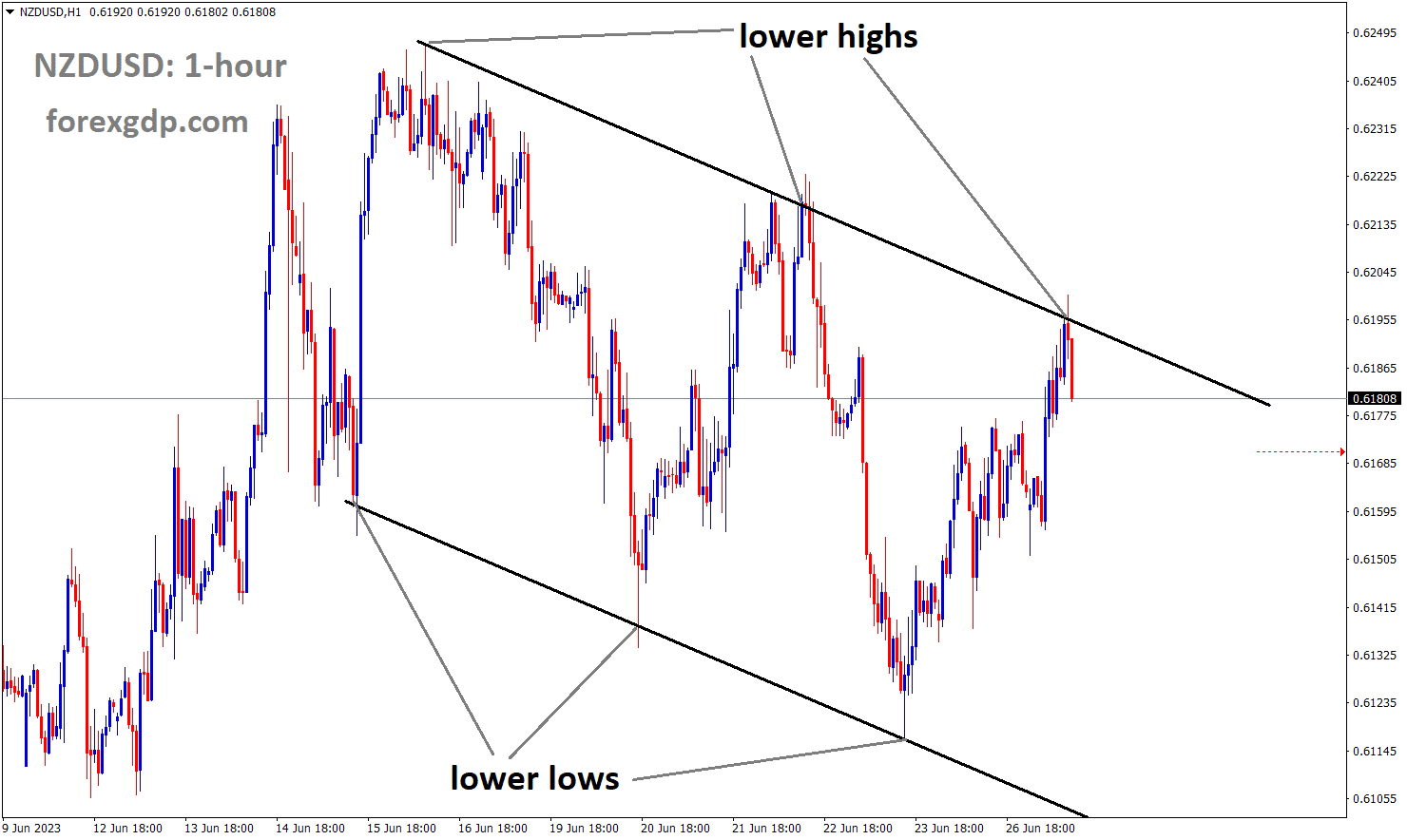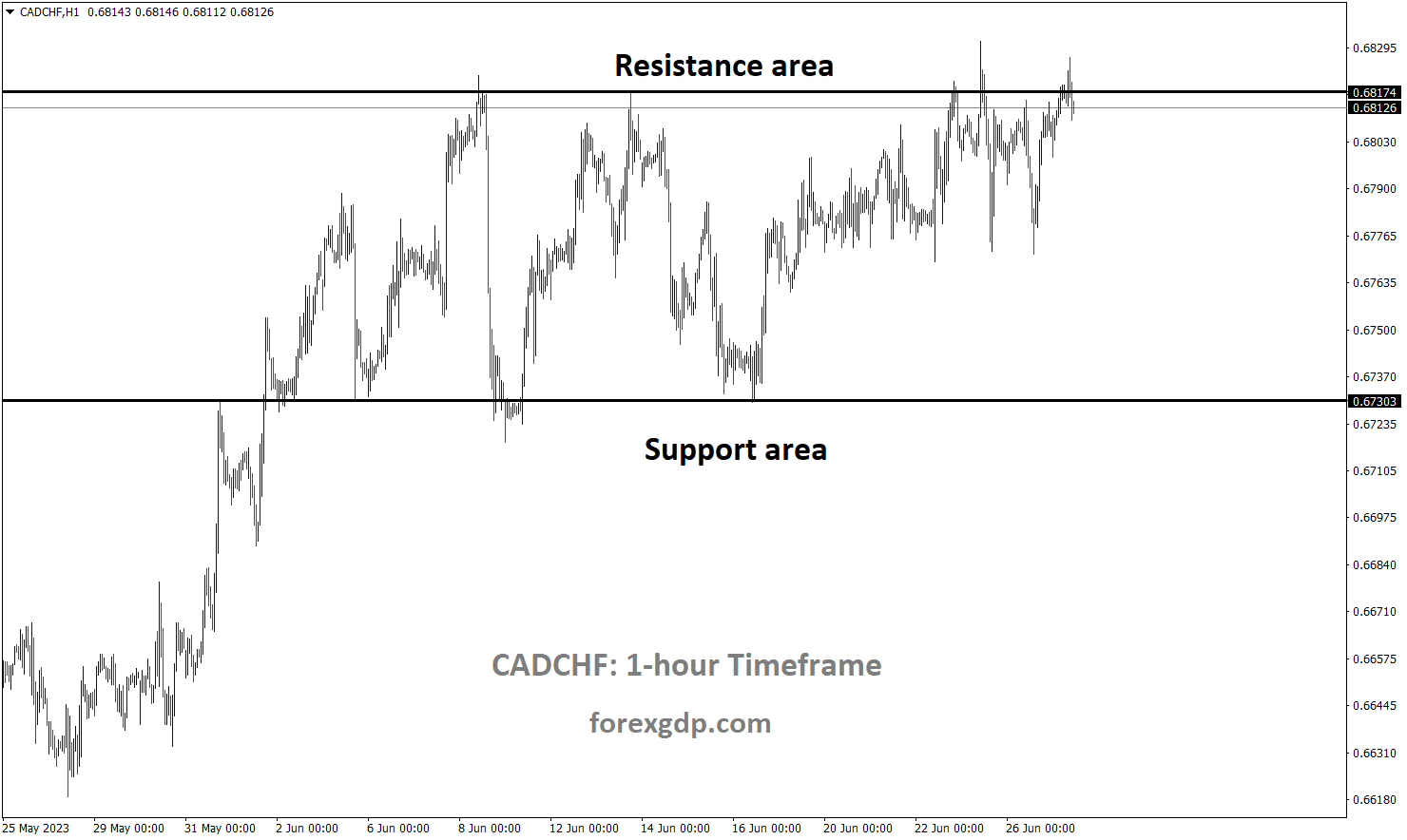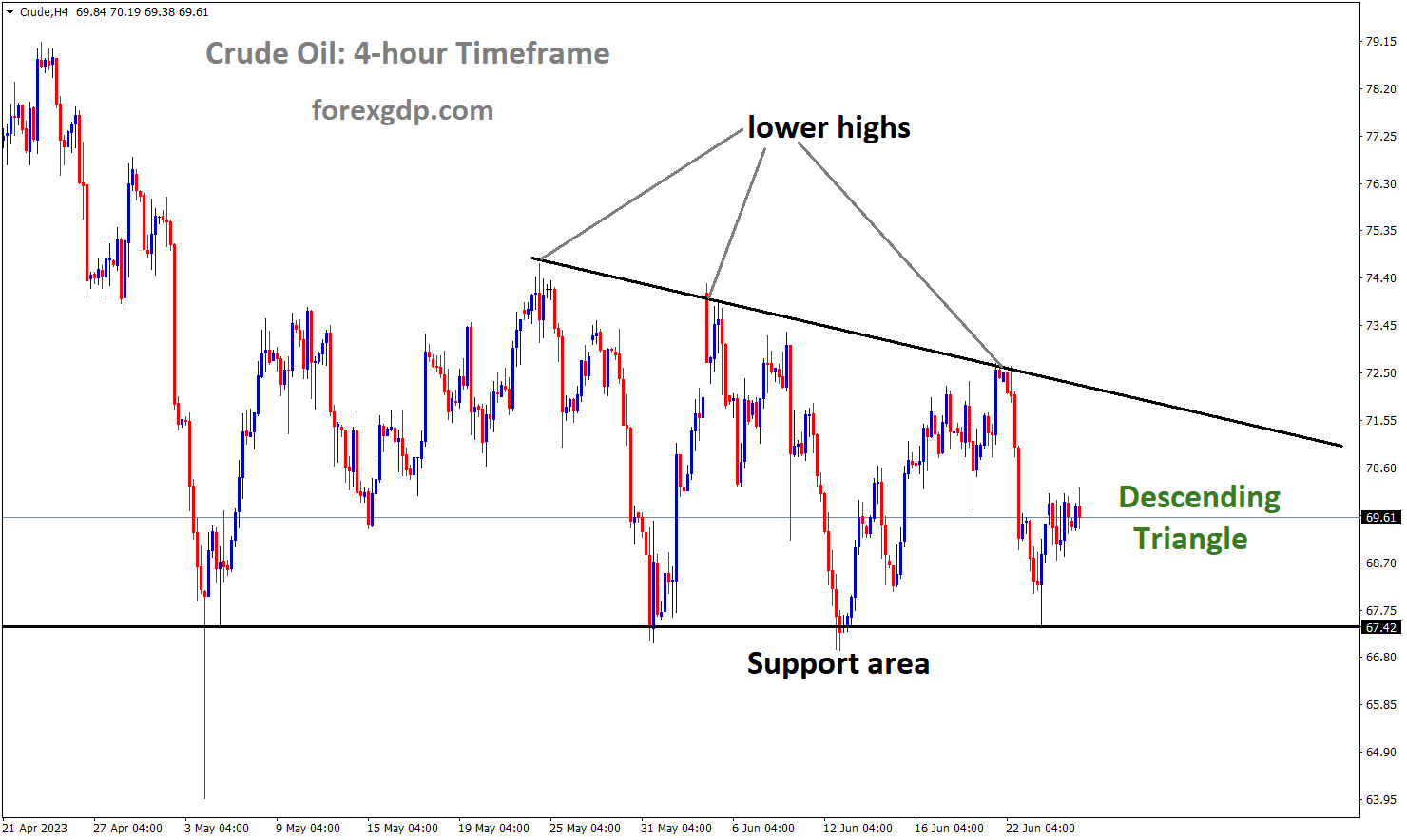GOLD Analysis
XAUUSD Gold Price is moving in an Ascending channel and the market has reached the higher low area of the channel.
Due to the potential for a global economic recession, gold prices are stable. All central banks have higher interest rates, which has decreased global demand for gold. Gold prices are consolidating ahead of US Consumer Confidence data.
Tuesday’s gold price struggles to gain any traction and trades in a constrained range just above $1,920 through the Asian session. The XAUUSD, on the other hand, is still quite close to the three-month low reached last Friday and appears vulnerable to a decline below the 100-day Simple Moving Average. The hawkish stance taken by major central banks, which continues to cap the price of non-yielding Gold, causes the market’s initial reaction to the weekend attempted mutiny by armed mercenaries in Russia to be short-lived. Recall that the Bank of Canada and the Reserve Bank of Australia both unexpectedly raised interest rates by 25 basis points earlier this month, and that the European Central Bank last week increased rates to the highest level in 22 years. Additionally, on Thursday, the Bank of England, the Swiss National Bank, and the Norges Bank all increased their benchmark interest rates. By the end of this year, borrowing costs may still need to rise by as much as 50 basis points (bps), according to the Federal Reserve (Fed). Additionally, during his two-day congressional testimony last week, Fed Chair Jerome Powell stated that the US central bank does not anticipate cutting interest rates anytime soon and will instead wait until it is certain that inflation is tumbling to the 2% target. Thus, Friday’s release of the US Personal Consumption Expenditures Price Index, the Fed’s preferred inflation indicator, will continue to be the centre of attention because it could affect expectations for the next policy move.
Investors will also be influenced this week by remarks made at a panel discussion in Sintra on Wednesday by ECB President Christine Lagarde, BoE Governor Andrew Bailey, Fed Chair Jerome Powell, and Bank of Japan Governor Kazuo Ueda. In the interim, attention will be focused on Tuesday’s US economic calendar, which includes the Richmond Manufacturing Index, New Home Sales, Consumer Confidence Index, and Durable Goods Orders. In contrast, the downside appears to be constrained in the wake of impending recession risks, which typically favour the safe-haven XAUUSD. Market participants appear concerned about potential economic challenges brought on by sharply rising borrowing costs. S&P Global’s Sunday announcement that it had reduced its 2023 growth forecast for China from 5.5% to 5.2% added fuel to the fears. The largest economy in Asia is expected to continue to grow, albeit at a “uneven” rate, according to the rating agency. This could prevent traders, at least temporarily, from making aggressive bets against the price of gold. The recent downtrend may, however, still be far from over, and the lack of any significant buying favours bearish traders.
USD INDEX Analysis
USD index is moving in the Descending channel and the market has fallen from the lower high area of the channel.
The US dollar is fluctuating ahead of US Consumer Confidence data and US Core Durable Goods Order. The tone of the US dollar has become more hawkish since US Fed Powell’s speech last week.
In spite of a slow Tuesday morning in Asia, the US Dollar Index picks up bids to retest its intraday high near 102.80 as it reverses the day’s losses. In doing so, the greenback’s index relative to the six most important currencies illustrates the market’s preference for safe-haven assets amid conflicting worries and also hints at the cautious atmosphere ahead of the important US data. S&P500 Futures display modest gains while reflecting the mood despite the benchmark Wall Street indexes and US Treasury bond yields closing on a negative note. However, recent bond coupons have been mainly slow. The positive US data from the previous day and the optimism surrounding the Federal Reserve also support the DXY’s run-up, in addition to the traders’ rush towards the US Dollar amid the market’s indecision. The US Dallas Fed Manufacturing Business Index for June improved on Monday to -23.2 from the previous readings of -29.1 and -26.5, respectively. US Core inflation for May allowed Fed Chairman Jerome Powell to maintain his hawkish stance over the past week, but the Purchasing Managers’ Indexes for June fell short of expectations. Even so, two additional interest rate increases this year would be a very reasonable prediction, according to Federal Reserve Bank of San Francisco President Mary Daly, who gave that signal on Friday.
It is important to note that market apprehensions coming from China and Russia join general scepticism about worries that the global economic recovery will stall, allowing the US Dollar Index to continue climbing. The US Conference Board’s (CB) Consumer Confidence data for June, expected to come in at 103.90 versus 102.30 prior, and the US Durable Goods Orders for May, expected to come in at -1.0% versus 1.1% prior, should be closely watched by traders following the US Dollar Index for clear direction. The speech made by Christine Lagarde, president of the European Central Bank (ECB), at the ECB Forum, will be significant as well. Should the US data come in weaker than expected and Lagarde persuade the policy hawks at the ECB, the DXY may experience a pullback.
EURUSD Analysis
EURUSD is moving in an Ascending channel and the market has reached the higher high area of the channel.
Martin Kazaks, a member of the ECB Board, stated that additional rate hikes will be made in the coming months to keep inflation at or below 2%. Market participants had incorrectly predicted that rate cuts would be made this year.
The Euro has maintained its upward trend since Monday. On the other hand, the US dollar is going through a downward correction, which has caused the USD Index to trade at two-day lows in the mid-102.00 range because US yields are not showing any clear direction. German 10-year bund yields are currently attempting a modest recovery. Martin Kazaks, a member of the ECB Board and a hawk, said that he sees rate hikes continuing past July despite the economy slowing down. He stated that he is currently unable to predict how much rates will rise. Additionally, he emphasised that the markets are mistaken in their predictions of rate cuts. The ECB President, Christine Lagarde, as well as board members Fabio Panetta, Isabel Schnabel, and Frank Elderson are all scheduled to speak at the annual ECB Forum on Central Banking in Portugal later on Tuesday.
Amidst growing concerns of an economic slowdown on both sides of the Atlantic, the Federal Reserve and the European Central Bank are still debating their potential next moves in normalising their monetary policies. According to recent remarks and testimony by Chair Jerome Powell, investors anticipate another 25 bps rate hike by the ECB in July, and the Federal Reserve is expected to follow suit. Durable Goods Orders and New Home Sales for May, the FHFA House Price Index for April, and the Conference Board’s measure of current-month consumer confidence are all scheduled for release later in the session. Tuesday’s additional USD selling gives the euro some support; Italy’s business and consumer confidence are next up, and the ECB Investor attention will be on the release of US Consumer Confidence before Lagarde and her colleagues speak later at the ECB Forum. US, German yields attempt a tepid rebound in the European morning.
EURJPY Analysis
EURJPY is moving in an Ascending channel and the market has rebounded from the higher low area of the channel.
Before Governor Ueda of the Bank of Japan’s dovish speech JPY fluctuates because Japan’s inflation rate is unstable. Demand should rise along with firmer wages in order to curb inflation.
Investors anticipate that the Bank of Japan (BoJ) will maintain its current dovish monetary policy in an effort to achieve sustainable inflation of 2%. As investors process their anxieties related to the possibility of higher interest rates from the Federal Reserve, S&P500 futures have added significant gains during the Asian session. Due to the impending quarterly result season, US equities were under selling pressure on Monday. Investors are concerned that the Federal Reserve’s higher interest rates are negatively affecting the outlook for the economy, which could affect quarterly results. The current support level for the US Dollar Index is 102.60. Before the United States Durable Goods Orders data for May are released, the USD Index is predicted to take a power-pack action. According to the consensus, the economic data will shrink by 1.0% as opposed to growing by 1.1%. Defense-related durable goods orders are projected to contract by 0.7%, but remain stable.
Examining the forward economic data reveals that the economic data will be impacted by fewer defence orders. The 10-year US Treasury yields have firmly recovered to 3.74%, in contrast to the USD Index, as investors expect the Fed to keep raising interest rates because the path to 2% inflation is still far from complete. Meanwhile, the BoJ Governor Kazuo Ueda’s speech is likely to make the Japanese Yen jive. BoJ Ueda is anticipated to take a dovish stance given that the effects of higher import prices are beginning to fade and the need for the central bank to boost demand through firmer wages in order to maintain inflation consistently above 2%.
Japanese Finance Minister Shunichi Suzuki stated that we closely monitor currency movements and take action if they become out of control. The impact of fundamentals caused a one-sided sharp increase in the value of the yen.
Shunichi Suzuki, the finance minister for Japan, stated on Monday that if foreign exchange moves become excessive, he will react appropriately. FX should reflect fundamentals steadily. Recent FX movements are abrupt and biassed.
GBPUSD Analysis
GBPUSD is moving in the Descending Channel and the market has fallen from the lower high area of the channel.
The British government struggled to keep prices from rising, so they asked businesses to reduce their profit margins in response to the public’s growing demand. They also reduced public sector workers’ salaries to curtail spending. More rate increases are necessary due to rising inflation, and the UK economy suffered from poor spending.
As the UK government looks beyond monetary tools to lower persistent inflation, the Pound Sterling has recovered to close to its immediate resistance of 1.2750. The adoption of new fiscal measures, such as the British government’s decision to reduce public sector employee wages, is supporting the recovery of the GBPUSD pair. The British government also urged businesses to reduce their profit margins in order to control sticky inflation, which could allay concerns about a gloomy economic outlook. The Bank of England was forced to announce a substantial rate hike of 50 basis points last week as a result of hotter-than-anticipated headline inflation in the United Kingdom and new highs in the core Consumer Price Index. Headline inflation remained higher than expected due to optimistic used car sales that more than offset a drop in energy prices. The unexpected 50 basis point (bps) increase in interest rates by BoE Governor Andrew Bailey has put the UK’s economic outlook in jeopardy. Because UK inflation turned out to be more persistent than anticipated, BoE policymakers were forced to announce significant rate increases. The headline inflation rate in the United Kingdom came in at 8.7% as rising costs for leisure-related cultural goods and services, air travel, and used cars more than offset a slight decline in historically high food inflation and declining petrol prices.
Despite constant policy tightening by the central bank, core inflation is still trending downward and reached new highs of 7.1%.
UK retail sales also exceeded expectations last week. While the market was expecting a 0.2% contraction, the monthly economic data increased by 0.3%. Although annualised retail sales declined by 2.1%, it was still better than expected because investors had anticipated a 2.6% decline. Since there is still a long way to go before price stability is achieved, BoE Governor Andrew Bailey has left the door open for additional interest rate increases. Economic outlooks are predicted to be negatively threatened by additional interest rate increases by the BoE. The effects of high UK inflation include a deteriorating reputation for the Conservative Party as Finance Minister Jeremy Hunt rolled back tax cut promises, citing the risk that their implementation would fuel inflationary pressures and undermine central bank efforts to reduce inflation. According to Bloomberg, UK FM Jeremy Hunt is in talks with industry regulators about the need for businesses to refrain from raising profit margins in order to capitalise on strong demand, or so-called greedflation, which could further damage the reputation of the British Conservative Party.
The UK government is stepping up efforts to control inflation by reducing wages in the public sector in addition to fighting greedflation. Because global equities are trading at lofty valuations and the quarter-end result season is quickly approaching, the general market mood is showing signs of a risk-averse theme. The Federal Reserve (Fed) is widely expected to raise interest rates in July, which has caused the US Dollar Index to recover after a corrective move. Rabobank analysts predict a rate increase in July but a slower pace of rate increases, which would mean skipping September and a potential second hike in November. Investors will be watching Tuesday’s 12:30 GMT release of the United States Durable Goods Orders data this week.
GBPCHF Analysis
GBPCHF is moving in an Ascending channel and the market has rebounded from the higher low area of the channel.
Thomas Jordan, the chairman of the SNB, announced that a pilot programme for digital currencies is being tested with market participants in six exchanges. Without proper regulations, CBDCs are never used with the general public; this pilot system is a test run to see how it performs in emergency situations like Covid-19.
According to the chairman of the Swiss National Bank, a wholesale central bank digital currency will be launched on Switzerland’s SIX digital exchange as part of a pilot programme on Monday. The goal of this is to test actual transactions with market participants; this is not just an experiment; real money equivalent to bank reserves will be used, Chairman Thomas Jordan stated at the Point Zero Forum. Jordan stated that the pilot project, which will soon begin, was only meant to last a brief period of time. As the use of cash has decreased, in some cases more quickly as a result of the COVID-19 pandemic, central banks around the world are researching digital versions of their currencies to prevent leaving digital payments to the private sector. The SNB has long been wary of using public, or retail, CBDCs, as opposed to wholesale CBDCs, which employ tokenized securities.
Jordan stated that while the use of retail CBDCs was more challenging to regulate, he was worried about the possible risks they could have for the financial system. We do not rule out the possibility that we will never introduce retail, but even so, we are being a little bit cautious right now, he added. Despite looking into digital currencies, SNB governor Andrea Maechler stated during a different panel at the Zero Point Forum that she does not see cash disappearing in Switzerland. According to her, it is the only way for ordinary people to hold money from the central bank. No matter the technology, that feature needs to be kept.
AUDUSD Analysis
AUDUSD is moving in the Descending channel and the market has fallen from the lower high area of the channel.
At the Economic Forum, China’s Premier Li Qiang stated that the country’s growth in the second quarter will be higher than it was in the first, and that by year’s end, we expect to have attained 5% annual economic growth. Today’s Australian Dollar to USD exchange rate increased due to this news.
In the early London session, the AUDUSD pair is trying to extend its recovery above 0.6720. The Australian asset has gained strength as investors anticipate positive second-quarter economic data from China. Despite Tuesday’s negative cues, S&P500 futures have made spectacular gains in Europe. The overall market climate has improved dramatically as investors have begun to let go of worries about a global recession brought on by central banks’ raising of interest rates. Investors are hoping that the Federal Reserve will pause its period of tightening monetary policy after raising interest rates in July, which is why the US Dollar Index is currently trading close to the day’s low of 102.55. The investing community is still divided about the financial outlook, though. A more moderate pace would mean skipping September, which would leave us with the meeting in November for the second hike, according to analysts at Rabobank.
In the meantime, the Australian Dollar has displayed exceptional strength as a result of investors’ optimism regarding China’s economic recovery in the second quarter following comments from China’s Premier Li Qiang. China’s Li stated at the World Economic Forum that economic growth will be higher in the second quarter than it was in the first and is anticipated to reach the annual economic growth target of about 5%, according to Reuters. He continued by saying that we would take additional practical and successful steps to increase the potential of domestic demand. It is important to remember that Australia is China’s top trading partner, and that the Australian Dollar would gain strength if China’s economy recovered. Investors will continue to pay close attention to Australia’s monthly Consumer Price Index data release. From the previous release of 6.8%, inflation is anticipated to soften to 6.1%. The Reserve Bank of Australia may be able to maintain a stable monetary policy as a result.
NZDUSD Analysis
NZDUSD is moving in the Descending channel and the market has fallen from the lower high area of the channel.
Grant Robertson, the finance minister for New Zealand, declared on Tuesday that the mission and charter of the Reserve Bank of New Zealand would be renewed. The framework for monetary policy has only minor adjustments. Instead of keeping, the MPC is now required to achieve and maintain inflation between 1% and 3%. MPC should explain the main factors that it takes into account when making decisions regarding financial risks.
CADCHF Analysis
CADCHF is moving in the Box Pattern and the market has reached the resistance area of the pattern.
After concerns about the global supply of fuel were allayed by Russia’s own political issues, crude oil prices spiked higher.
This week, the Canadian Dollar benefited from rising oil prices and did so ahead of CPI inflation data.
Crude Oil Analysis
Crude Oil Price is moving in the Descending triangle pattern and the market has rebounded from the horizontal support area of the pattern.
The price of crude oil is rising due to worries about potential supply disruptions, particularly those associated with Russia’s political unrest. To a greater extent, this allayes concerns about how a global economic downturn will affect fuel demand. This is perceived as providing support for the commodity-linked Loonie. The traders may decide to hold off on placing risky bets until the most recent consumer inflation data from Canada are released. The crucial CPI report will have an effect on the Bank of Canada’s policy outlook and the Canadian Dollar.
Don’t trade all the time, trade forex only at the confirmed trade setups.
Get Live Free Signals now: forexgdp.com/forex-signals/

